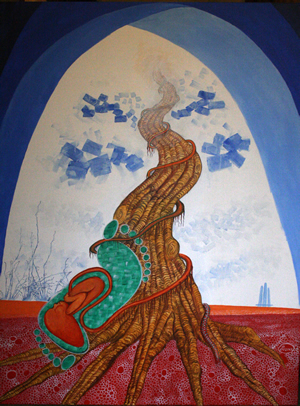-Raphael Warjri
The matrilineal clan lineage is considered sacred by the Khasi people till today, even as the extent of sanctity has declined in the urban middle – class society, due to the onslaught of popular and dominated patriarchal culture. Perhaps, the term matriliny needs to be redefined in the Khasi context of clan relationship to achieve a more precise and specific definition. The attachment of the maternal mother and paternal mother to their respective children in the process of human reproduction system is abided in all respects. The paternal mother is considered as the provider of a father, a male parent responsible for contributing the seeds to another core family, while the distinct identity of the paternal and maternal families is maintained separately through the mother of each particular clan. The father keeps the clan of his mother and his wife, and children retain the clan of their mother or grandmother. Mothers have always been held in high regards in the society and considered the core in the formation of the cognate family, while the maternal uncles are the defender of the honour and integrity of the core family. All the descending children or siblings trace their ancestry from the mother, and the umbilical cord is a string of life within the clan.The Khasi myth about U Lum Sohpetbneng, literally means the Mount of Heavenly Navel,isthe foundation of the genesis of mankind. The myth relates that the souls of human race descended from heaven through the Golden Vine on the Mount of Heavenly Navel; in Khasi- Ka Jingkieng Ksiar U Lum Sohpetbneng. Therefore, the world view of Khasi myth is universal and inclusive of the entire humankind; notably, the soul of the entire human race descended from heaven through the Golden Vine of the Mount of Heavenly Navel.

This Khasi myth on the genesis of humankind is the founding principle of the traditional system of Khasi matrilineal clan lineage. The matriliny in the ancient Khasi society prevailed for eon before the emergence of the essence of faith as a religious system, through which incantation and libation, rituals and ceremonies are being performed in every aspect of social, cultural and political situation in the society. The anthropological theory substantiated that initially, every human society practiced matriliny because of the fact that every mother is the immediate companion of her own children by virtue of birth and natal nourishment. In the ancient past, every infant cling to their mother for emotional and physical support and protection till they are capable of independent movement on their own personal ability. The surviving culture of the matrilineal system has a firm foundation in every communities throughout the world, which they have been able to sustain in spite of the overwhelming dominant patriarchal system that became the social trend for every modern society at most countries in the world. Contrary to the rigid tenets of Islam religion towards female members in the society, the majority Muslim populace among the Minangkabou people of Indonesia, is still the largest community practicing matrilineal culture with endurance and absolute commitment. The same is prevalent to many matrilineal societies across the world, even as there are some who had converted to or assimilated with the patriarchal system, while few others are in the process of change. Nevertheless, many communities are strongly abided by the matrilineal system of clan lineage. Prominent among them are the Musuo in China, Akan, Ashanti and Tuareg in Africa, the Serer of Senegal, Gambia and Mauritania, Minangkabou of Indonesia, Khasi and Garo of India and Bangladesh.
Social change takes place in the way that is best suited to a particular community in a given situation in the present context, which that particular generation might not be able to foresee the future prospect of the community in terms of the survival of their respective ethnic identity. The matrilineal custom of the Khasi community has its roots in the creation myth about the genesis of mankind.
The universal context of matriliny encountered several complex situations in the course of interface with other cultures. Therefore, it is significant and appropriate to emphasise only in the Khasi matrilineal system of clan lineage. The tradition of matriliny in Khasi society have existed since the genesis of mankind and before the indigenous belief is being revered as a religious faith. Man fell into the temptation of a mammon serpent demon ‘Thlen’ to challenge and defeat the tiger, a spiritual guardian or ‘Ryngkew Basa’ with mischievous scheme of selfish creatures. Doom descended upon the earth, when the graceful sun concealed in the sacred cavern ‘Krem Lamet Latang‘ due to the outrageous remarks by certain beings during the dance festival of all creatures. The divine council commanded a decree upon few prominent beings to facilitate the return of light and warmth of the mother sun. The arrogance and conceited attitude of few creatures was futile, until a humble and insignificant naked rooster succeeded to convince the return of the sun at dawn after he crows for three times as was agreed upon with the instruction of the mother sun. Therefore, the rooster is revered as the harbinger and saviour of mankind, where sacrifice is being performed as ritual to communicate with the divine energy through the entrails of a fowl. This is the emergence of the Khasi faith and belief system that prevailed till today. The matrilineal system is intrinsic to the faith, that the authentic identity of a Khasi race is generally ascribed by majority of the people, even among those who have embraced other religions. In the universal context, it is significant to comprehend that mitochondrial DNA establishes the specific identity of every descendants to the mother, as compared to nuclear DNA which identifies the progeny to both parents.

